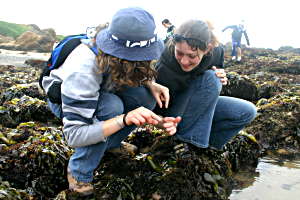 Learning at the tidepools. Credit: Amy Gotliffe
Learning at the tidepools. Credit: Amy Gotliffe
This question comes up endlessly in the world of environmental education. How do you inspire a person to learn, care and then take action for the environment? As someone whose professional goal is to inspire earth stewardship, I often ask anyone who will answer this big question.
Many are active stewards because they formed a connection with nature during childhood. This bond is deep, instinctive and primal, and was merely coaxed out by a particular, yet often simple experience outdoors: playing in the woods, on the rocks, in the creek, in the garden, in the dirt, up the tree, with the roly polys, in the ditch, in the pond, in the vacant armory (ok that was me), etc. Somewhere deep inside, a door was opened to the potential to really care. This is why Nature Deficit Disorder is so disturbing, as we wonder if children growing up void of trees and ditches and ponds have forged the same bonds.
When a child's natural curiosity is nurtured by an adult, they will likely develop an even stronger connection. Some will have this head start, yet it is never too late.
So, how does a person then become an active steward?
